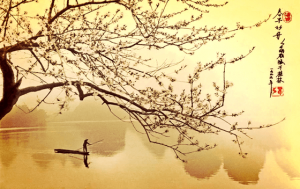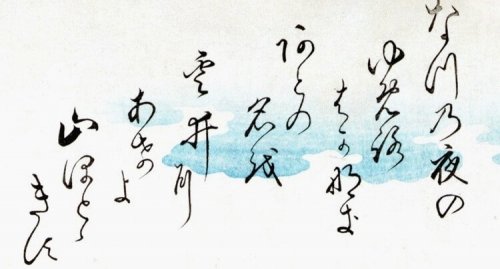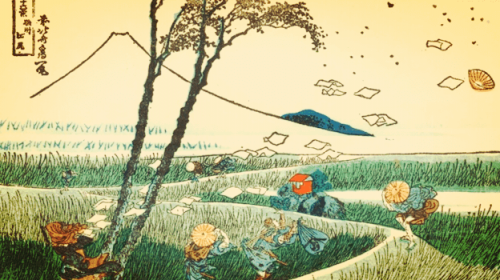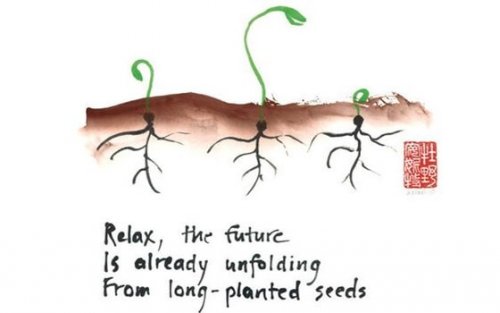Haiku to Free Your Emotions


Written and verified by the psychologist Valeria Sabater
A Haiku is a short poem inspired by the emotion of the moment, wonder, and our connection with nature. It is a Japanese tradition that strips things down to the soul to help with recovery and gather courage, resilience, and strength. In fact, its cathartic and liberating nature makes it the perfect psychological tool. In addition to being aesthetically pleasing, you can use haiku to free your emotions.
Some say that the brain is like a museum of infinite galleries filled with distorted images. Finding meaning in what is displayed there isn’t always easy. So, that’s why it can be useful to utilize other artistic techniques to find meaning, order, and calm in the midst of all the chaos.
“Along this road
going with no one
autumn evening”
-Matsuo Basho-
That is what haikus are able to achieve. Haikus are short poems formed by three verses of 5, 7, and 5 moras, or syllables. The goal of a haiku is to look at universal themes from the perspective of a child. Haiku aims to transcend from the ordinary to the magical and turn off the noise of obsessive and ruminating thoughts. The idea is to stay contained in the emotion of the moment.
For many people, it is almost like looking at the world through a dewdrop. It is about staying connected to a concrete moment to gain a different perspective. To see things through a lens that makes everything more intense and much brighter.

Haiku as a psychological tool
Robert Epstein is a well-known writer and psychologist at the University of Harvard. He has written books like The Sacred in Contemporary Haiku and many articles that point to the benefits of haiku as therapy. Thanks to his writing and advocacy, we know that this type of writing is very useful in treating addiction. In fact, as Dr. Epstein says, “a good haiku can work wonders on a tired soul.”
Now, it’s clear that we are not talking about a treatment that can lead to complete recovery or remission from addiction or depression on its own. This is a complementary tool that helps us connect with ourselves. This tool helps find that forgotten place where hope still resides. It can lead us to the path of resilience and that field of bamboo where we can be strong but flexible in the face of adversity.
On the other hand, it is common to associate the practice of haiku with the world of Zen. It is important to point out, however, that it is a much more ancient practice. While it’s true that Zen philosophy drew on haiku to disseminate its ideas at a given moment in time, haiku is much older than Zen. Haiku has always been a channel of expression and emotional liberation for Japanese men and women. Japanese culture uses haiku to contemplate the tranquility of nature and to find a way to give shape to and express their sadness, desire, and joy.
“Is the light
that fades an empire
or a firefly”
-Jorge Luis Borges-

Furthermore, it is interesting to note that many experts see haiku as an excellent way to practice mindfulness. The person practicing mindfulness should open herself, be receptive to the sensory world to capture the moment and be aware of her inner-self. It is a fabulous tool to learn to slow down, put your worries into perspective, and generate feelings of calm, peace, and compassion.
How to write a good Haiku
Matsuo Basho is the most famous poet from the Edo period in Japan. He is also one of the poets most successful in popularizing the use of Haiku. According to his words, a good poem is one that captures the essence of the moment. A good haiku expresses an instant shared between us, our souls, and nature.
Lengthening days,
accumulating, and recalling
the days of distant past.-Yosa Buson-
So, if you want to try this therapeutic art, follow the instructions below. It is important to note that the true usefulness of haiku comes when you are able to forget about the rules, meter, and structure. This happens with time and practice. If you stick to it, then you can truly free your mind.
- Haiku doesn’t rhyme or have titles.
- The ideal metric for a haiku is 5 syllables in the first line, 7 in the second, and 5 in the third.
- Verbs get in the way because you are not supposed to express movement. The idea is to capture an immobile image or an emotion.
- The verb “to be” shouldn’t be included, it is already implied.
- Simplicity rules.
- Haiku is not a reflective or finished poem.
- A good haiku expresses something that transcends the moment, yet at the same time, it is something that can only be expressed “in the moment”.
- Haikus tend to include the “kigo”, or a reference to nature or to the current season.
- Haikus are private, they pertain only to us. That’s why we should imitate or use easy or simple images… A good poem demands intimacy, awareness, and emotional freedom.

In conclusion, remember that haiku is a brush-stroke in time from the heart of the person who writes it. It is a channel, a sigh that we breathe to express ourselves for ourselves. A simple piece of advice is to remember that the most beautiful haikus are the ones that take a leap in the third verse. The first two lines are a simple introduction, and the third leaves the best impression.
A Haiku is a short poem inspired by the emotion of the moment, wonder, and our connection with nature. It is a Japanese tradition that strips things down to the soul to help with recovery and gather courage, resilience, and strength. In fact, its cathartic and liberating nature makes it the perfect psychological tool. In addition to being aesthetically pleasing, you can use haiku to free your emotions.
Some say that the brain is like a museum of infinite galleries filled with distorted images. Finding meaning in what is displayed there isn’t always easy. So, that’s why it can be useful to utilize other artistic techniques to find meaning, order, and calm in the midst of all the chaos.
“Along this road
going with no one
autumn evening”
-Matsuo Basho-
That is what haikus are able to achieve. Haikus are short poems formed by three verses of 5, 7, and 5 moras, or syllables. The goal of a haiku is to look at universal themes from the perspective of a child. Haiku aims to transcend from the ordinary to the magical and turn off the noise of obsessive and ruminating thoughts. The idea is to stay contained in the emotion of the moment.
For many people, it is almost like looking at the world through a dewdrop. It is about staying connected to a concrete moment to gain a different perspective. To see things through a lens that makes everything more intense and much brighter.

Haiku as a psychological tool
Robert Epstein is a well-known writer and psychologist at the University of Harvard. He has written books like The Sacred in Contemporary Haiku and many articles that point to the benefits of haiku as therapy. Thanks to his writing and advocacy, we know that this type of writing is very useful in treating addiction. In fact, as Dr. Epstein says, “a good haiku can work wonders on a tired soul.”
Now, it’s clear that we are not talking about a treatment that can lead to complete recovery or remission from addiction or depression on its own. This is a complementary tool that helps us connect with ourselves. This tool helps find that forgotten place where hope still resides. It can lead us to the path of resilience and that field of bamboo where we can be strong but flexible in the face of adversity.
On the other hand, it is common to associate the practice of haiku with the world of Zen. It is important to point out, however, that it is a much more ancient practice. While it’s true that Zen philosophy drew on haiku to disseminate its ideas at a given moment in time, haiku is much older than Zen. Haiku has always been a channel of expression and emotional liberation for Japanese men and women. Japanese culture uses haiku to contemplate the tranquility of nature and to find a way to give shape to and express their sadness, desire, and joy.
“Is the light
that fades an empire
or a firefly”
-Jorge Luis Borges-

Furthermore, it is interesting to note that many experts see haiku as an excellent way to practice mindfulness. The person practicing mindfulness should open herself, be receptive to the sensory world to capture the moment and be aware of her inner-self. It is a fabulous tool to learn to slow down, put your worries into perspective, and generate feelings of calm, peace, and compassion.
How to write a good Haiku
Matsuo Basho is the most famous poet from the Edo period in Japan. He is also one of the poets most successful in popularizing the use of Haiku. According to his words, a good poem is one that captures the essence of the moment. A good haiku expresses an instant shared between us, our souls, and nature.
Lengthening days,
accumulating, and recalling
the days of distant past.-Yosa Buson-
So, if you want to try this therapeutic art, follow the instructions below. It is important to note that the true usefulness of haiku comes when you are able to forget about the rules, meter, and structure. This happens with time and practice. If you stick to it, then you can truly free your mind.
- Haiku doesn’t rhyme or have titles.
- The ideal metric for a haiku is 5 syllables in the first line, 7 in the second, and 5 in the third.
- Verbs get in the way because you are not supposed to express movement. The idea is to capture an immobile image or an emotion.
- The verb “to be” shouldn’t be included, it is already implied.
- Simplicity rules.
- Haiku is not a reflective or finished poem.
- A good haiku expresses something that transcends the moment, yet at the same time, it is something that can only be expressed “in the moment”.
- Haikus tend to include the “kigo”, or a reference to nature or to the current season.
- Haikus are private, they pertain only to us. That’s why we should imitate or use easy or simple images… A good poem demands intimacy, awareness, and emotional freedom.

In conclusion, remember that haiku is a brush-stroke in time from the heart of the person who writes it. It is a channel, a sigh that we breathe to express ourselves for ourselves. A simple piece of advice is to remember that the most beautiful haikus are the ones that take a leap in the third verse. The first two lines are a simple introduction, and the third leaves the best impression.
This text is provided for informational purposes only and does not replace consultation with a professional. If in doubt, consult your specialist.







